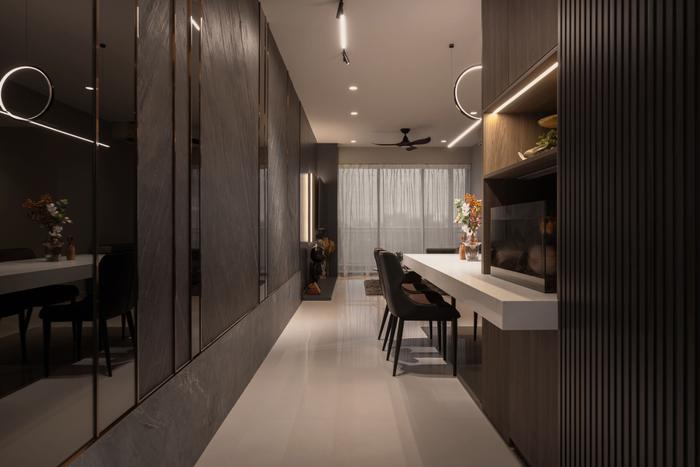Make an informed decision before signing on the dotted line.
When it comes to viewing resale property, we often pay attention to the surrounding amenities, transport options, sun direction and the size of the unit – but less so about how the condition and layout of the flat itself will factor in during the renovation.
That’s why we spoke with interior designers to understand how to view resale units in light of any renovations you’ll do down the road.
Here are some practical tips and common oversights to help you assess a unit’s renovation potential.
1. Think about your game plan before viewing the unit

View this project by Charlotte's Carpentry
Before you even step into a unit, it helps to know how extensively you plan to renovate. Will you be hacking everything and rebuilding from scratch? Or are you hoping to keep existing flooring and built-ins to save costs?
"The condition doesn’t matter if you plan to gut the whole space," says Yang Horng, an interior designer from Charlotte’s Carpentry. "But if you want to retain certain features to save, then you have to check different aspects carefully as the condition of the unit could incur more unexpected costs."
Besides that, think about whether you want certain features like an open kitchen or a walk-in wardrobe, as the layout could obstruct the creation of such features.
2. Ask the seller some key questions
When you’re viewing a flat, it’s also about what you don’t see. Ask the seller questions like:
Were there any renovations or upgrades made to the property previously?
If yes, probe on when upgrades were made, and what was changed or created as the original floorplan may not reflect these changes.

View this project by Artspaze
Paisley, an interior designer from Artspaze, advises homeowners to think twice about purchasing units that have not previously been renovated in more than 20 years (assuming you’re not planning on a gut renovation).
This is because the condition may be rather poor, in which case you would have to pay more to upgrade the unit.
How old is the electrical wiring and air-conditioning units?
Yang Horng highlights that both wiring and air conditioner units any older than 20 years could be worn out and in need of replacing, especially if you plan to stay in the flat in the long term.
“If not, after you’ve stayed for about 2-3 years in your newly-renovated home, problems may crop up that you need to spend more money and time to fix,” he says.
Is there anything hidden behind carpentry, the false ceiling or in box-ups?

View this project by Artspaze
When it comes to such hidden works, you wouldn’t be able to assess their condition just by viewing them.
Asking about how piping is run could also help to identify if anything is in poor condition, since these are only apparent when hacking starts.
Has the unit undergone HIP (Home Improvement Programme)?

View this project by Charlotte's Carpentry
For HDB flats, the HIP scheme involves essential improvements like upgrading the electrical load if necessary, repairing spalling concrete and replacing waste discharge stacks. Some optional improvements include upgrading the existing toilet or bathroom.
If the unit has undergone HIP in the recent past, several issues may have been resolved and the overall condition of the unit would be better to work on.
Have there been any past issues the seller is aware of?

View this project by Charlotte's Carpentry
This could range from leaks and poor drainage to water seepage and mould. In spaces like the wooden flooring of outdoor balconies in condominiums (or in HDBs with balconies), keep an eye out for pest infestations.
3. Identify any potential issues while viewing the unit
Then, assess the following personally when you’re on site:

View this project by Artspaze
Electrical works and false ceilings: Look at the sockets and switches. Are they old or mismatched? You can also check with the seller if any sockets are not working.
Plumbing: Look out for visible leaks that could indicate the plumbing is in poor condition (e.g. around pipes, sinks or toilets). Stains and mould growth on the ceiling and/or around the aircon trunking could also indicate water seepage.
Walls and ceilings: If you’re viewing the unit at night, turn on the lights and look closely. "Cracks on the walls and unevenness are more visible under artificial lighting than daylight," Yang Horng shares. Such wavy walls and/or patchy ceilings might require replastering, which adds to the cost.

View this project by Charlotte's Carpentry
Flooring: Both Paisley and Yang Horng highlight that expensive flooring like marble and parquet are worth retaining if they’re in relatively good condition since you’d just have to polish/add a protective coating.
Tap on tiles to listen for hollow sounds – a sign they may pop soon – and peeling vinyl might mean it’s time for an update.
Carpentry: If you’re planning to retain any carpentry, look for signs of water damage, warping, or pests.
Doors and windows: Do they open and close smoothly? Replacing windows can be costly (and for HDB flats, involves applying for a permit).
4. Watch out for layout limitations

View this project by Artspaze
No matter how thoroughly you check the interior, the household shelter blocking the way to your dream open kitchen will ruin all your plans.
This is one of two examples Paisley highlights on how the home’s layout – and structural walls – could affect your plans. The second example relates to walk-in wardrobes.
“In some of the older resale flats, the master bedroom has a storeroom next to it which can be hacked and converted into a walk-in wardrobe. But in others, it’s far away down the hall, which means they have to hack one of the junior bedrooms instead to convert into a walk-in wardrobe.”

Floor plan of a resale Executive Apartment with slanted bedroom walls | View this project by Charlotte's Carpentry
Yang Horng also points out that it’s important to consider the overall shape of the unit.
“Some units also have an odd shape, with curves or slanted walls, which could result in dead space which is difficult to furnish or work with. These aren’t always obvious in the floor plan, and something you can only see when you view the unit.”
Paisley adds that in condos specifically, bay windows may limit the space in the rooms and sometimes, tall glass windows/doors may also limit how carpentry can be built in the space.
For bay windows, a common solution is to extend a built-in platform bed to the bay window to reclaim some space.
Look beyond the surface when viewing resale flats

View this project by Charlotte's Carpentry
Viewing a resale flat through a renovation lens can help you make a more informed decision – and save you any hassle down the line.
To sum it all up:
- Ask about the renovation history, especially more on the wiring and piping
- Check finishes for signs of water seepage, cracks and uneven/damaged surfaces
- Be mindful of hidden issues behind carpentry/box-ups
- Check windows, built-ins, and the overall layout
On the other hand, if you’re planning on a gut renovation, the layout is likely the only thing you’d need to consider.

View this project by Artspaze
While no home is ‘perfect’, knowing what you’re potentially working with and identifying dealbreakers can help with making realistic plans, be it for budget or potential layout changes.
Whenever you’re ready to start your renovation, simply click the button below to let us know your requirements and we’ll connect you with interior firms – for free.
Got a question for us? Leave a comment down below! 👇

 Get a budget estimate before meeting IDs
Get a budget estimate before meeting IDs